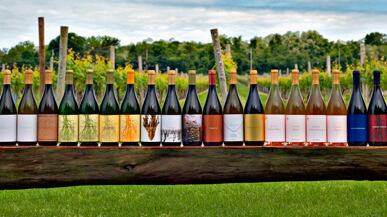Picture a 180-pound man at a vineyard in Bridgehampton wearing waders and standing on top of a ton of whole grape bunches beneath a billowing white tent that might otherwise be used for a lawn party. With music blaring through the earbuds of his iPhone, he stomps his feet to crush the fruit. Five minutes later, he is up to his thighs in liquid that is quicksand thick. He works up a sweat. The juice bubbles and gives off heat as it begins to ferment.
This is not a remake of the classic I Love Lucy episode, “ Lucy’s Italian Movie.” It is a portrait from the annual harvest at Channing Daughters Winery on Long Island’s South Fork, where Christopher Tracy, the exuberant and slightly manic winemaker, insists that the age-old custom of donning waders and stomping on clusters of whole grapes is the gentlest extraction method for red grape varieties in a cool-climate region.
“It’s a conscious choice about style and structure,” he says. “There is one person per bin to express the juice. We don’t crush everything. We want whole berries. The goal is to make wine that is structured, supple and sexy, which means minimizing the extraction of green unripe tannins.”
ADVERTISEMENT
Tracy’s ability to look at the winemaking process with freedom and draw upon techniques that have fallen from fashion comes from being part of a team of winemaking iconoclasts operating in a region free from historical constraints. The North and South Forks of Long Island may have sunlight and soil reminiscent of the Loire Valley, but 40 years ago there were potato fields where vineyards are now planted.
The vineyard’s founder, Walter Channing, a sculptor who works with discarded tree trunks, is the founding partner of C.W. Group, a venture-capital business with a focus on health care. Tracy’s mentor Larry Perrine, Channing Daughters’ CEO and co-owner (known affectionately as “the guru” in winemaking circles), earned advanced degrees in soil studies, microbiology, enology and viticulture, concentrating on the interaction of soil, climate, and wine on Long Island. A partnership with the viticulturist Steve Mudd provides access to North Fork Vineyards planted in the 1970s. Tracy founded a theater company before attending the French Culinary Institute, working as a pastry chef, then going on to earn a sommelier certificate and a diploma from the International Wine Center. He's a Master of Wine candidate.
Gallery: Annual Harvest at Channing Daughters Winery

With 7,000 bottles spread over 26 bottlings, Channing Daughters fuses the creative energy of experimental theater with the hand-made values inherent in artisanal winemaking. Tracy plants the classic international grape varieties Cabernet Sauvignon, Sauvignon Blanc, Pinot Noir, Merlot, Chardonnay and Petit Verdot, along with more esoteric Austrian and Italian varieties such as Blaufränkisch, Dornfelder, Lagrein, Refosco, Pinot Bianco, and Malvasia. He ferments white wines with their skins on and calls them "orange wines." He ferments wines using indigenous wild yeast and lets the barrels sit outside. He co-ferments white and red fruit. He creates field blends by growing several grape varieties in one vineyard then harvesting and fermenting them together. He uses gravity bottling. He blends freely—in a wine called Sculpture Garden the sweet spice and bramble flavors of Blaufränkisch flesh out the plums and blueberries of Merlot.
Despite this constant effort toward pushing boundaries in the vineyard and in the cellar, Tracy’s skill as a winemaker is most evident where his wines are straightforward and easy to compare. For example, his Mudd West Vineyard Sauvignon Blanc strikes the perfect balance between the classic French and New Zealand styles.
“This was an idyllic year.” Tracy says. “It was so warm. A lot of stuff fermented spontaneously.”
The harvest brings out the theater producer in Tracy. Picking usually begins the second or third week in September. This year, because of the heat, everything happened earlier. For the first time on record, picking began before Labor Day with the early ripening whites, Muscat Ottonel, Pinot Grigio and the field blend Sylavanus. It moved on to Sauvignon Blanc, Chardonnay, Tocai Friulano and the field blend Mosaico. Once the whites were picked, the vineyard crew turned to the early reds, Dornfelder, Blaufränkischand Lagrein, and then to the Syrah, Cabernet Sauvigon, Merlot, and Petit Verdot.
The white wines are front-loaded into the press, while the "orange wines" and red wines are taken to the vats beneath the tents to be crushed. When the skins and stems begin to form a cap on top of the vats, they are punched down by hand. Finally, the wine is transferred by bucket to oak barrels or stainless-steel casks. The underlying belief is that gentle handling of the fruit leads to wines that are floral or aromatic, depending upon the characteristics of the grape.
“This was an idyllic year.” Tracy says. “It was so warm. A lot of stuff fermented spontaneously. We harvested 200 tons of wine, 60 tons of red. We had over 175 tons picked and in by September 25, so we only had four small lots of Merlot left when the rains came. We picked the grapes in beautiful weather the following weekend. The bunches were healthy, clean and very ripe. We were very lucky. If you go back and look at the radar maps, the bulk of the rains tracked west and east of us!”
Plus: Check out Hungry Beast, for more news on the latest restaurants, hot chefs, and tasty recipes.
Sophie Helene Menin writes about food and wine, sense of place and the pleasures of the table. Her work has appeared in The New York Times, Departures and Saveur, among other publications. She lives in New York City.





